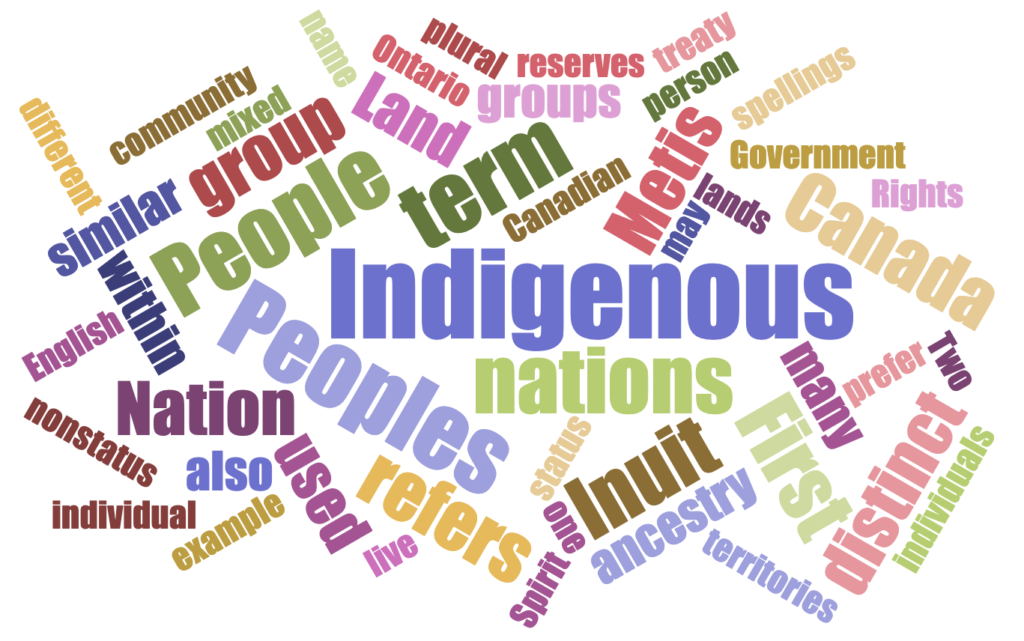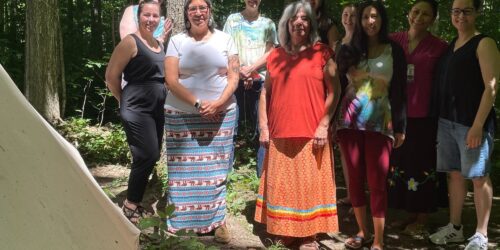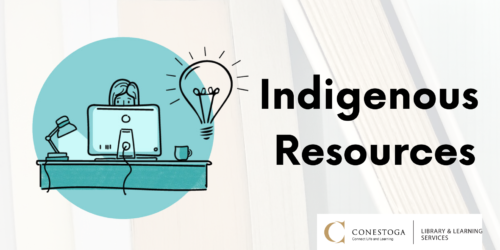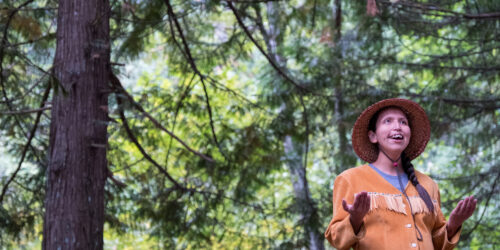Terms for First Peoples in Canada
This post describes the importance of respecting the self-naming practices of the First Peoples, and provides a partial list of terms for talking about First Peoples.
Note: This post has been written from the perspective of a settler living on the traditional lands of the Attawandaron, Anishinaabeg, Haudenosaunee, and Lunaapeewak Peoples in London, Ontario. I acknowledge the limitations that my identity and positionality place on this post. One limitations, for example, is that as a settler, I cannot offer insight into hearing terms used to talk about First Peoples. My intention in preparing this post is to take responsibility for my own learning on this topic, and contribute to the decolonization and Indigenization of post-secondary spaces. Writings and research by First Peoples have informed this post to incorporate a perspective other than my own as well as amplify diverse First Peoples’ voices.
A History of Colonialism through Language
” Language is important and it frames the ways in which we think about the world.”
(Animikii, 2020, n.p.)
Language is a fundamental part of how people understand and describe themselves.
The First Peoples of Canada have always had unique communities and names. However, when colonization of Indigenous Peoples began, language was used to govern, control, and erase Indigeneity (Joseph, 2016a). Early colonizers created or changed Indigenous names to ones they could pronounce. Laws and cultural practices continue to invent and use language that generalizes and stereotypes Indigenous people and groups.
The oppression of Indigenous Peoples includes the terms used to refer to First Peoples considering how Indigenous Peoples refer to themselves. The Truth and Reconciliation Report (2015) describes the profoundly negative effects of the systemic erasure of Indigenous identities, languages, and cultural differences on First Peoples. First Peoples have the right to self-determination as part of the truth and reconciliation process (Government of Canada, 2021).
Reclaiming Names and Naming Practices
“Indigenous Peoples have frequently taken the stand that they are best capable of, and morally empowered to, transmit information about themselves. They have the right to tell their own story.”
(Younging, 2018, p. 2).
Indigenous Peoples are striving to reclaim their unique names for their communities and cultural affiliations. As well, certain terms are being identified as perpetuating harmful stereotypes and inaccurate views about the homogeneity of Indigenous peoples and cultures.
Settlers in Canada can help to support the ongoing process of truth and reconciliation by using the language and terms Indigenous Peoples use to describe who they are, including their cultural affiliations. By knowing more about how First Peoples refer to themselves–and what terms perpetuate a colonialist perspective–settlers model for students the importance of understanding the history of colonialism and the importance of respecting and honouring the perspectives and languages of Indigenous Peoples.
See this overview video with Inuk journalist Ossie Michelin, which gives a brief overview of How to talk about Indigenous peoples (CBC News, 2017) [2:37].
Talking to, and About, First Peoples
“How do we ensure we are who we say we are? The best way is to let us define ourselves. We have our own ways of relating to one another and determining tribe, nation, clan, and community. And when we ask one another, “Where are you from?” or “Who claims you?” it’s not an attempt to police identity or alienate, it’s an acknowledgement of the importance of community.”
(Lefebvre & Elliot, 2017, n.p.)
It is important to recognize that language is ever-changing, that context matters, and that each person will have their own perspective and preferences about names. For instance, settlers continue to use words such as “Indigenous,” which were not self-chosen and so may not be preferred (Lefebre & Elliot, 2017). When speaking with, or about, First Peoples, use the terms they use and are respectful and as specific as possible.
You may encounter different spellings of terms. For example, “Ojibwe has been called by many names including Anishinaabemowin, Ojibwe, Ojibway, Ojibwa, Southwestern Chippewa, and Chippewa” (Ojibwe’s People’s Dictionary, 2021). This is in part because the Ojibwe language is a chain of linked local varieties and dialects, not a single standardized language (Ojibwe’s People’s Dictionary, 2021). When using a specific spelling, refer to a direct source informed by the perspectives of those people.
Finally, note that the terms in the list below is neither a comprehensive nor definitive; rather, the goal is to provide an entry point into common and respectful terms. While sources by Indigenous authors and informed by Indigenous perspectives have been consulted, it is always best to refer to First People about their own names and terms.
Read more on terms to use and avoid, and suggested way to use terms in the classroom.
Terms to Use and Consider When to Use
Band or Indian Band – A group of First Nations whose membership is defined by the Canadian Government. This is a legal term defined by the Indian Act (1985).
First Nations – A noun primarily used broadly to identify Indigenous People (both status and non-status) who are neither Metis nor Inuit (Queen’s, n.d.). A term that refers to one of the six main geographic groups of early First Nations in Canada, as within each of these areas the peoples that were understood to have similar cultures shaped by a common environment (Government of Canada, 2017).
Some communities, such as those in Ontario, have expressed publicly and politically that they prefer Indigenous Peoples (Joseph, 2016a).
Indigenous / Indigenous Peoples – Indigenous is used to refer to a specific land and the people who have occupied those lands. In Canada, it is an umbrella term for status and non-status First Nations, Metis, and Inuit. Indigenous describes people all over the world who were the first peoples in a land. Many people prefer Indigenous over Aboriginal (Indigenous Peoples of Manitoba, 2016).
Indigenous is an English term. While the term Indigenous identifies in English First Peoples as a collective group who live in similar circumstances, others criticize the term as ambiguous and failing to acknowledge unique identities or distinct rights (Guelph, n.d.).
The expression Indigenous Peoples in Canada can also be confusing for how it may include Indigenous Peoples from other lands (e.g., Māori or American Indian; Queens’s n.d.).
Inuit – Indigenous people who are culturally similar that inhabit the circumpolar Artic land, including the Maritimes and various Northern territories. Eskimo is considered derogatory. Inuit and Innu are distinct groups. Inuk refers to a singular person of Inuit ancestry. The word Inuit means People, so using the term “Inuit people” is redundant.
Metis – People of mixed Indigenous and European ancestry who have emerged through subsequent intermarriage of mixed ancestry individuals. The Metis have a distinct history, culture, language and territory. Metis are covered by the Indian Act as of 2016. Use the acute accent over the ‘e’ in Métis unless quoting a name or source in which it is not used.
Nation (preceded by the name) – Nation refers to a federally recognized community or cultural group, e.g., “the Mohawk Nation” (Queens, n.d.). For example, the Haudenosaunee, Anishinabek, Attawandran, and Lunape Nations steward territories on which Conestoga College is situated.
There may be different words and spellings depending on whether referring to an individual or a group. For example, Anishinabee refers to an individual, while Anishinabek is plural for individuals as well as groups of Nations. There are also different spellings for men and women. For instance, Anishinabekwe refers to female Aninshinabe person. The Anishinabek Nation is a political advocate for 39 member First Nations across Ontario. (Anishinabek Nation, 2022).
Peoples – The plural peoples recognizes that more than one distinct group comprises the Indigenous populations of Canada (Indigenous Foundations, n.d.). There are about 614 distinct cultures/traditions (Union of BC Indian Chiefs, 2014).
Reserve – Land set aside for Indigenous Peoples of Canada. Only registered members of the community can live on reserves. There can be many reserves within treaty boundaries (Canadian Encyclopedia, 2018). Reservation is a term used in the United States that refers to an entire treaty area (Guelph, n.d.).
Two Spirit People
A pan-Indigenous term that “acknowledges the varied and diverse traditions of gender and sexual diversity that have and continue to exist within many Indigenous nations of North America” (Journalists for Human Rights, 2017). It is a self-identified term that includes multiple understandings of gender and sexuality, although there is no universal definition of Two Spirit.
Terms to Generally Avoid
These terms are widely regarded as anachronistic, derogatory, or offensive. They should be avoided or used only within specific historical or legal contexts.
Aboriginal People – A collective noun used in the Constitution Act of 1982. Some First Nations do not prefer to be called Aboriginal People. Do not use the term “Aboriginals” unless as an adjective, or “our Aboriginal people,” which is profoundly insulting.
Indian – There are 3 legal categories of “Indian”: a) an Indigenous Person who is registered under the Indian Act, b) a non-status person who has lost their status, c) a member of a community whose ancestors signed a treaty with the Crown. The term should be avoided as derogatory and outdated unless used as part of a historical reference or citing legal, policy, constitutional matters, e.g., “Indian Bands.” Some communities continue to use it in their tribal name, e.g., Osoyoos Indian Band. Learn more about the origin of the term by visiting The Canadian Encylopedia entry.
Native/Native Canadian – An outdated collective term that has been replaced largely by the term Indigenous. Some First Peoples refer to themselves as “Native,” but non-Indigenous people should not use it to identify others, as it does not account for any distinctiveness between groups and may still hold negative connotations for some.
Tribe – The term has negative connotations, and in the Canadian context should generally be avoided.
What You Can Do in the Classroom
Below are some steps to take to use terminology appropriately in your classroom when speaking or writing about First Peoples of Canada.
Avoid Stereotypes and Generalizations
Some English terms and expressions that refer to First Peoples and their culture perpetuate stereotypes and suggest a monolithic culture. These include “Indian Princess” and “low man on the totem pole.” Consider the implications of the expressions and names that you use and the negative impact they have on First Peoples (National Museum, 2022).
Follow First Peoples
Advice from experts who consult on working with First Peoples suggest that people should “go with what they are calling themselves.” For instance, in Ontario or Manitoba, avoid using the term Aboriginal. Check the website of the community you are working with to see what terms they are using (Joseph, 2016a).
The best term is always what an individual person or tribal community uses to describe themselves. If you are in doubt about the most appropriate term to use to refer to a person or their cultural affiliation, ask the person or group in a discreet and respectful way. If you are asking students, avoid tokenism and assuming that one Indigenous student’s response represents all students. Learn what terms are used in your area, and ask someone knowledgeable. Always check sources for how they identify (including pronouns), and do not presume identities.
Be As Specific as Possible
Avoid generalization when possible. Be specific about an individual or group whenever possible. If you are referring to more than one community in a single group, then use terms like First Nation. If you are referring to multiple groups, then use broader terms like Indigenous.
Be aware that broad terms can imply there is no difference among groups. For instance, Aboriginal is an umbrella term that categorizes all Indigenous Peoples in one homogenous group (Animikii, n.d.). If you are unsure about how or where to use the terms Indigenous or Aboriginal, use “First Nation, Indian, Metis, and the Inuit Peoples” (Joseph, 2016b). Whenever possible, have students learn about specific individuals from a community.
Capitalize Terms
Terms that identify Indigenous Peoples (e.g., Indigenous, Aboriginal, First Nation, Inuit, Metis) should be capitalized as form of respect, the same way that English, French, and Spanish are capitalized. Lowercase suggests anyone local to any area.
Avoid Possessive Phrases and Plural Possessive
Avoid using possessive phrases like “Canada’s Indigenous Peoples” or “our Indigenous Peoples,” which has connotations of ownership. Instead, use “Indigenous Peoples of Canada.”
The plural possessive for First Nations, Indigenous Peoples, Aboriginal Peoples, etc. does not generally use an apostrophe. Generally, there is no need to use the apostrophe to connote ownership, e.g., First Nations’ housing.
Use the Present Tense
The past tense negatives the experience and cultures of First Peoples in Canada and reinforces the myth of the “Vanishing Indian.” Use the present tense to ensure Indigenous Peoples are perceived as having a living and contemporary culture (National Museum, 2022).
Read Resources on Indigenous Writing
Contestoga’s library has a digital book in its holdings, Elements of Indigenous Style (2018). This published guide answers common questions and issues of naming as well as style and process.
Gregory Younging. (2018). Elements of Indigenous Style : A Guide for Writing By and About Indigenous Peoples. Brush Education. Conestoga Library Services permalink.
See an online resource, Indigenous Peoples: A Guide to Terminology (n.d.).
References
Anishinabek Nation (2022). Anishinabek Canadian Encyclopedia (2018). Reserves.
Animikii. (2020). Why Language Matters.
Government of Manitoba (2016). Indigenous Peoples of Manitoba: A Guide for Newcomers.
Government of Canada (2021). Principles respecting the Government of Canada’s relationship with Indigenous peoples.
Government of Canada (2017). First Nations in Canada.
Guelph University (n.d.) Language matters; Understanding First Nation, Inuit and Metis terminology.
The Indian Act ( RSC , 1985, c. I-5).
Indigenous Foundations. (n.d.). Terminology.
Journalists for Human Rights, 2017). Style guide for reporting on Indigenous peoples.
Joseph, B. (2016a). Indigenous vs Aboriginal. Indigenous Corporate Training. https://www.ictinc.ca/blog/indigenous-vs.-aboriginal
Joseph, B. (2016b). Indigenous Peoples terminology guidelines for usage. Indigenous Corporate Training https://www.ictinc.ca/blog/indigenous-peoples-terminology-guidelines-for-usage
Lefebrve, M. & Elliott. A. (2017). We didn’t choose to be called Indigenous. The Walrus.
Ojibwe People’s Dictionary (2021). About the Ojibwe Language.
Queen’s (n.d.). Terminology guide.
National Museum of the American Indian (2022). The Impact of Words and Tips for Using Appropriate Terminology: Am I Using the Right Word?
Truth and Reconciliation Commission of Canada. (2015). Canada’s residential schools: Missing children and unmarked burials (Vol. 4). McGill-Queen’s University Press.
Union of BC Indian Chiefs (2014). Key Definitions.




